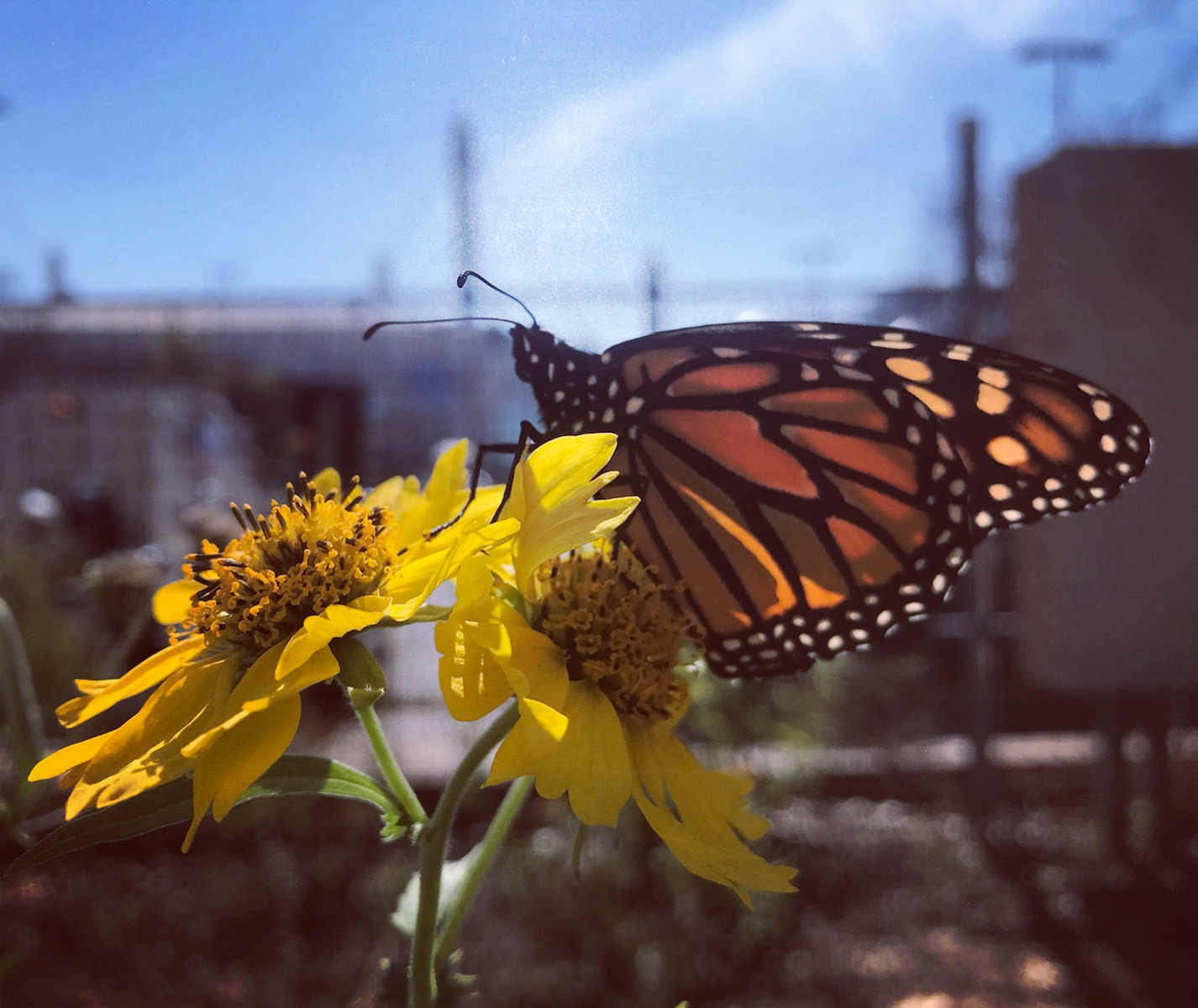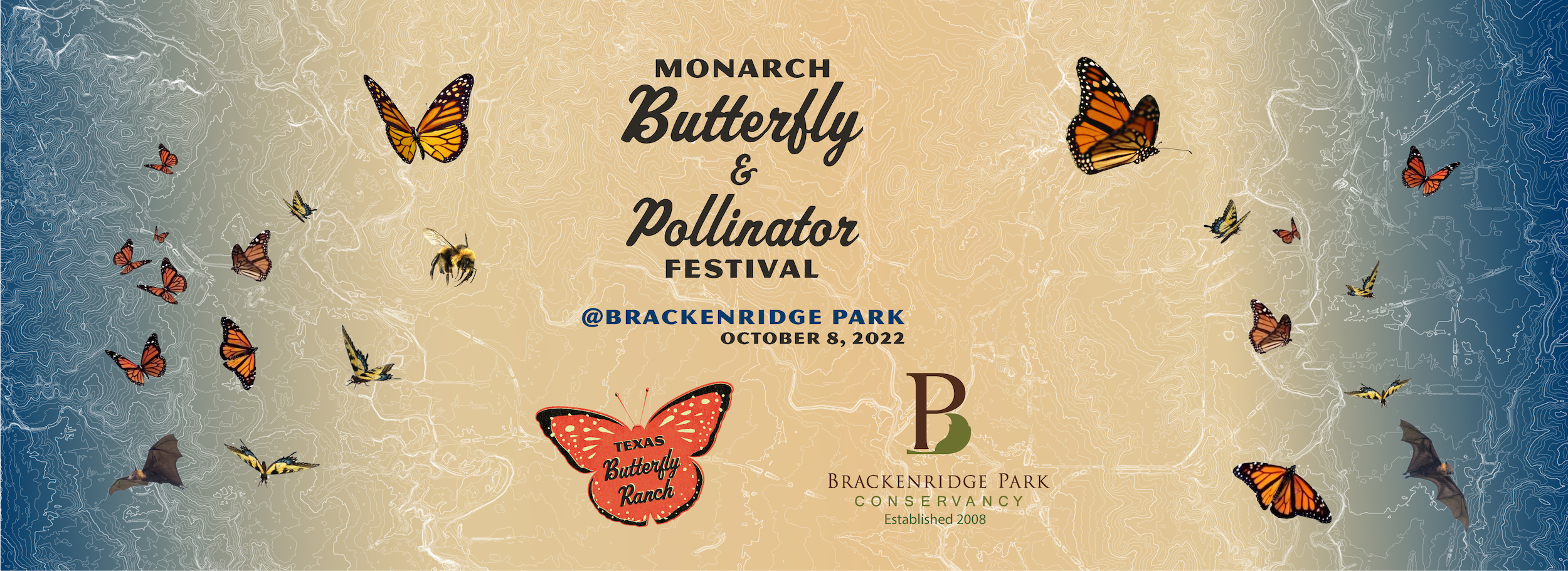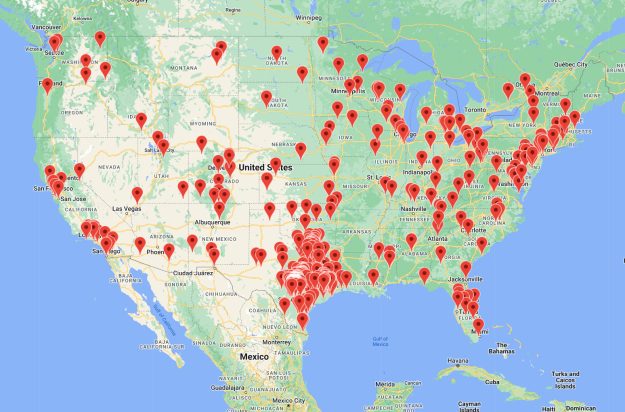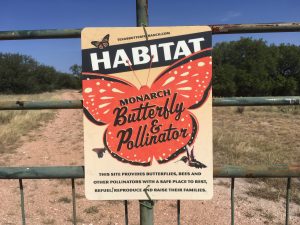One of the most impactful things you can do to help migrating monarchs and other wildlife is to plant a pollinator habitat. That’s why we’re inviting you to welcome birds, bees, butterflies and other wildlife into your landscape by pledging to plant a pollinator habitat as part of our 2022 Monarch Butterfly and Pollinator Festival.
Our goal for 2022: 1,000 habitats pledged.

Monarch butterfly on Cowpen Daisy in downtown San Antonio pollinator garden. –Photo by Brendan Gibbons
Our Pollinator Habitat Initiative started in 2018, when the Texas Butterfly Ranch launched 300for300, an effort to create 300 pollinator habitats for San Antonio’s Tricentennial birthday. We surpassed that goal with 325 habitats, then challenged the community to help us reach 500 pollinator habitats pledged by 2020. That goal, too, was exceeded.
As of this writing, our Pollinator Habitat Initiative boasts 834 gardens pledged. With your help, a goal of 1,000 habitats seems within reach by the end of this year.
The Pollinator Habitat Initiative was inspired by the National Wildlife Federation (NWF) Mayor’s Monarch Pledge. The nationwide campaign, launched in 2015, invited mayors along the IH-35 migratory pollinator pathway to pledge to execute up to 24 action items that would increase pollinator habitat in their cities.
In December of 2015, San Antonio became the first city in the nation to agree to act on all 24 recommendations made by the NWF, making it the first Monarch Butterfly Champion City in the country. A citywide pollinator gardening initiative was among the action items pledged.
That sparked our initial locally grown 300for300 program, but then we expanded expanded the effort beyond the Alamo City. Now, our map boasts habitats from Texas to Canada and California to Delaware.
For those in San Antonio who need a bit of hands-on guidance, our friends at Rainbow Gardens and Blooming with Birdie have organized several Pollinator Gardening 101 classes with accompanying garden starter kits that take place throughout October. See our Festival calendar page for details. We also have plenty of resources below.
The requirements for a pollinator habitat are not difficult to achieve.
- At least six different native and/or well-adapted, noninvasive plants, including
- At least two larval host plants (the plants on which butterflies lay their eggs)
- At least two spring nectar plants (plants that bloom in the spring, providing energy/fuel)
- At least two autumn nectar plants (plants that bloom in the fall, providing energy/fuel)
- A diverse mix of spring, summer, and fall blooms.
The goal, of course, is to make sure that insects, birds and other wildlife have a place to rest, refuel, reproduce and raise their families. Native plant and pollinator habitats also conserve water, help reduce flooding and build soil in the ecosystem. Check out our resources page for plant lists, useful websites and other guidance to help you get started.
And be aware, sometimes neighbors and HOAs mistake a pollinator habitat for a lazy gardener.
For example, in early 2019, Don Kirchhoff of San Antonio received a letter from the Forest at Stone Oak HOA asking him to mow the “weeds” in his front yard. It cited him and his wife, Joyce Peterson, with a breach of the HOA’s declaration of covenants, conditions, and restrictions, the legal guidelines that govern most communities with HOAs.
The violating “grass, weeds and vegetation” were in fact, bluebonnets–the state wildflower of Texas–that were setting blooms.
The couple was accused of violating a regulation stating that “grass, weeds, and vegetation on each Lot shall be kept mowed at regular intervals.” Kirchoff defended his pollinator habitat with letters and data, ultimately “winning” the right to landscape with native plants.
“I think we educated them a bit,” said Kirchoff, the founder and a past president of the San Antonio chapter of the Native Prairies Association of Texas,
That said, having a sign that communicates the intentionality of your landscape can help avoid such dramas. It can also inspire others and educate the community, including those who think a pristine lawn is the only option. Pollinator habitat signs are available in our shop.
It’s never too late to get on the map and pledge to plant a pollinator garden. And no, there’s no pollinator police that come and check your progress. We trust that if you take a moment to pledge, you will follow through and create a welcoming environment for the wildlife that keeps our ecosystems intact.

Join us October 8 at Brackenridge Park in San Antonio. Native plant and tree adoption events will be taking place, along with many other activities.
Do it now and help us reach 1,000 habitats in 2022. Here’s the link.
TOP PHOTO: Pollinators welcome: goldenrod, purple aster, cowpen daisies, lantantas and other late season blooms create a pollinator pitstop in downtown San Antonio. Photo by Monika Maeckle
Related posts:
- HOAs resist native plant landscaping despite conservation benefits
- Flower bed works overtime as overnight bachelor pad for solitary bees
- 300for300 pollinator initiative: 500 habitats by 2020
- Popularity of pollinator gardens growing in areas prone to drought
- Planting a butterfly garden? Here’s tips on how to do it
- Mostly native butterfly garden outperforms lawn every time
- A year in the life of an urban butterfly garden
- Downtown River walk plot converts to pollinator garden, creature haven
- San Antonio becomes first National Wildlife Federation Monarch Champion city
Like what you’re reading? Don’t miss a single post from the Texas Butterfly Ranch. Sign up for email delivery below, like us on Facebook, or follow us on Twitter, or Instagram.




I have planted milkweed in my garden here in Central TX (outside if FT Hood) for 2 years now. I just got hit bad again with oleander aphids. I watch a good amount of milkweed videos and I never see infestation to the degree that I seem to get. I have 5 plants this year and all 5 have them on it. I sprayed them last week with water to knock them off but today I noticed tiny caterpillars. How can I keep my plants healthy and safe for my butterflies?
Umm. Don’t Butterflies “hatch” from Caterpillars? Caterpillars ate nearly all my parsley, but then the plant grew back again.
I have the same problem in Houston. I would like to find the answer as well.
I have the same problem in Floresville. I tried a Neem spray, and picking them off manually. I just don’t know what to do.
[…] favorite pollinator — and educational booths with information and action-oriented activities like pledging to become a pollinator habitat. This year’s goal is 1,000 […]
This year I had small black ants on my milkweed and that took care of my aphid problem. I had two Monarch Caterpillars, but I’m sure it got too cold in Kansas before they could get big enough to spin chrysalises – they
just disappeared. I’ve noticed that they hatch later and later every year, at my home in southwestern Kansas –
I’m wondering how to get them to show up earlier so more of them can emerge and get to Mexico…I’m also wondering if the black ants ate some of the Monarch eggs too…I suppose that could happen…anyone know?